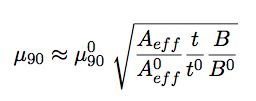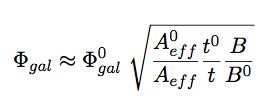John Kelley, UW-Madison, May 2005
![]()
We would like to estimate the sensitivity of IceCube to the muon neutrino flux from the outer galactic plane, using the results from this analysis. To calculate a new sensitivity, we can approximate how much the signal and background will increase for IceCube as the effective area, angular resolution, and exposure time increase.
The mu90 increases approximately with the square root of the number of background events, and thus with the square root of effective area, solid angle, and exposure time. Since we cannot change the solid angle in the galactic longitudinal direction, we express it as the on-source region size B:

The number of signal events increases approximately linearly with the effective area and exposure time:

Thus the sensitivity scales approximately as follows:

Now, for a true line source, we can decrease the on-source window size as much as our increase in angular resolution allows. So for 5 years of IceCube data, assuming an increase of effective area of 40x, and an increase in angular resolution of 3x, we achieve an increase in sensitivity of a factor of 12 over this analysis (with four years of AMANDA-II data).
Unfortunately, this is not close to the level predicted by Ingelman and Thunman for the outer galactic plane (approximately the middle of the dark gray band in figure 4.4). We need over two orders of magnitude improvement to reach this level of sensitivity. The situation is even worse for a Gaussian signal, because we are unable to tighten the angular cut substantially without losing more signal.
One possible solution is the use of an energy cut. A cut on n-channel did not provide any benefit for this analysis, but with better energy reconstruction in IceCube, the sensitivity to a harder spectrum (such as an index of -2.4) could possibly be increased with the use of an energy cut of some kind.
Another approach is suggested by Candia in a recent paper (astro-ph/0505346). He suggests that the cosmic-ray density may be enhanced enough in the center of the galaxy that the flux of neutrinos may be detectable in IceCube — using showers, however. No such enhancement is suggested for the outer galaxy. It seems likely that we will detect point-like hotspots in the galactic plane with IceCube long before a more diffuse flux is detected.